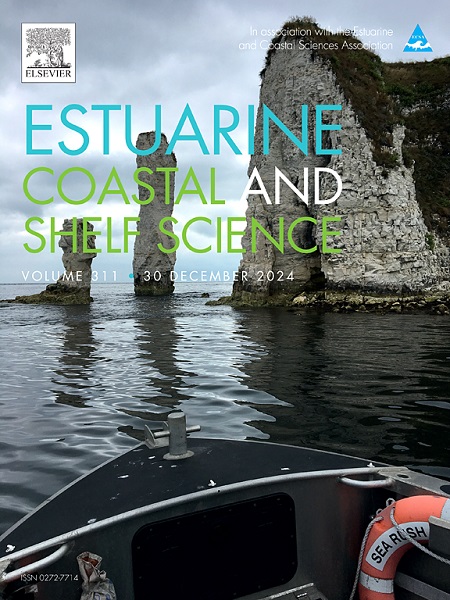中国典型滨海复垦湿地土壤有机碳动态变化及其影响因素
IF 2.6
3区 地球科学
Q1 MARINE & FRESHWATER BIOLOGY
引用次数: 0
摘要
海岸带潮湿地是重要的蓝碳生态系统,具有显著的固碳能力。了解滩涂复垦对土壤有机碳(SOC)及其组成的影响,对有效的湿地管理和制定相关政策具有重要意义。本研究收集了江苏省东台市不同土地利用类型的表层土壤和沉积物样本96份,包括未填海滩涂(0年)和填海历史分别为10年、15年、25年、40年和50年的填海场地。结果表明,土壤有机碳含量随着开垦年龄的增加而增加,25年后达到8.92 g/kg的峰值。不同垦区土壤有机碳含量差异不显著,但林地土壤有机碳含量最高(8.71 g/kg),具有较强的碳汇潜力。土壤溶解性有机碳(DOC)、易氧化性有机碳(EOC)和微生物生物量碳(MBC)含量也随时间增加而增加。其中,东台海垦区的EOC平均含量最高,为1.59 g/kg。林地的活性碳含量最高(DOC: 4.14 mg/kg, EOC: 2.27 g/kg, MBC: 50.16 mg/kg)。土地利用类型对DOC和EOC含量有显著影响,但对MBC没有显著影响。土壤湿度、pH值和氮输入等环境因子对有机碳动态也有影响。氮肥添加对滩涂和水田土壤有机碳和有机碳的影响显著,对土壤有机质和有机质的影响不明显。这些发现为沿海土地开垦对土壤碳库的长期影响提供了有价值的见解,对可持续土地管理具有启示意义。该研究强调了优先考虑具有高碳汇潜力的土地利用(如林地)以及优化土壤水分、pH值和养分投入以增强碳库稳定性的重要性。本文章由计算机程序翻译,如有差异,请以英文原文为准。
Dynamic changes in soil organic carbon and influencing factors in typical coastal reclaimed wetlands of China
Coastal tidal wetlands are key blue carbon ecosystems with significant carbon sequestration capacity. Understanding the effects of tidal flat reclamation on soil organic carbon (SOC) and its components is essential for informing effective wetland management and policy. This study collected 96 surface soil and sediment samples from Dongtai City, Jiangsu Province, across various land use types, including un-reclaimed tidal flats (0 years) and reclamation sites with 10, 15, 25, 40, and 50 years of reclamation history. Results showed that SOC content generally increased with reclamation age, peaking at 8.92 g/kg after 25 years. While SOC content differences among post-reclamation land use types were not statistically significant, woodland exhibited the highest SOC levels (8.71 g/kg), highlighting its superior carbon sink potential. Additionally, contents of soil dissolved organic carbon (DOC), easily oxidizable organic carbon (EOC), and microbial biomass carbon (MBC) also increased over time. Among these, EOC exhibited the highest average content (1.59 g/kg) across the Dongtai reclamation area. Woodland consistently showed the highest active carbon component content levels (DOC: 4.14 mg/kg, EOC: 2.27 g/kg, MBC: 50.16 mg/kg). Land use type significantly influenced DOC and EOC contents but had no substantial effect on MBC. Environmental factors such as soil moisture, pH, and nitrogen input also impacted SOC dynamics. Notably, nitrogen addition significantly affected SOC and EOC levels in tidal flats and paddy fields, with less pronounced effects on DOC and MBC. These findings provide valuable insight into the long-term impacts of coastal land reclamation on soil carbon pools, with implications for sustainable land management. The study emphasizes the importance of prioritizing land uses with high carbon sink potential, such as woodland, and optimizing soil moisture, pH, and nutrient inputs to enhance carbon pool stability.
求助全文
通过发布文献求助,成功后即可免费获取论文全文。
去求助
来源期刊
CiteScore
5.60
自引率
7.10%
发文量
374
审稿时长
9 months
期刊介绍:
Estuarine, Coastal and Shelf Science is an international multidisciplinary journal devoted to the analysis of saline water phenomena ranging from the outer edge of the continental shelf to the upper limits of the tidal zone. The journal provides a unique forum, unifying the multidisciplinary approaches to the study of the oceanography of estuaries, coastal zones, and continental shelf seas. It features original research papers, review papers and short communications treating such disciplines as zoology, botany, geology, sedimentology, physical oceanography.

 求助内容:
求助内容: 应助结果提醒方式:
应助结果提醒方式:


